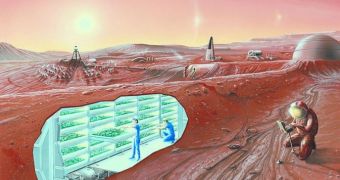Undoubtedly, one of the greatest problems facing a potential human colony on Mars or the Moon is dust. This is especially true in the case of the Red Planet, which is covered in the stuff. Dust devils and sand storms are common occurrences, and these natural events have the ability to significantly disrupt any type of human activity that astronauts may set up at those locations. But a new type of levitation technology could help with these difficulties, and all that it requires to work are stereo loudspeakers, Wired reports.
Experts at the University of Vermont, led by physicist Junrun Wu, say that this method could have significant benefits for astronauts manning a permanent outpost on either the Moon or Mars. The configuration is detailed in the January issue of he renowned Journal of the Acoustical Society of America. Wu reveals that the basic operating principle behind the new technology is blasting a wave of high-pitched noises from a pair of stereo loudspeakers through a focusing pipe. The ensuing vibrations are enough to lift the dust off any surface, including Martian or lunar soils.
Zoltan Sternovsky, a University of Colorado in Boulder (UCB) physicist who was not involved in the new study, explains that dust on other planets is nothing like our own. In the case of the Moon, for instance, there is no atmosphere to move the stuff around and make it round, as it happens on Earth. As a direct consequence, lunar dust is highly abrasive, and its action on rovers, landers and astronaut spacesuits can be likened to that of freshly broken glass. This naturally means that the equipment employed for space exploration will degrade very fast, with potentially devastating consequences for explorers' chances of survival.
In the lab experiments conducted at UV, the team placed mock lunar and Martian dust on the surface of a solar panel. On the Red Planet, dust has a high electrostatic charge, meaning it easily adheres to everything. The normal, 4-volt output of the panel was reduced to 0.4 volts after the dust was added. The team then used tweeters to produce the sonic vibrations and, four minutes later, the solar panel was able to achieve as much as 98.4 percent of its maximum voltage capabilities. This demonstrated that the method was highly effective in removing even static-charged dust.
However, there is a catch to the new system, in that it only works in pressurized enclosures, where there is actual air around. The Moon is out of the question, as it has no air to speak of, while its effects on Mars will be drastically reduced on account of the low atmospheric pressure there. “We made this very clear, this technique only works in a space station,” Wu concludes.

 14 DAY TRIAL //
14 DAY TRIAL //